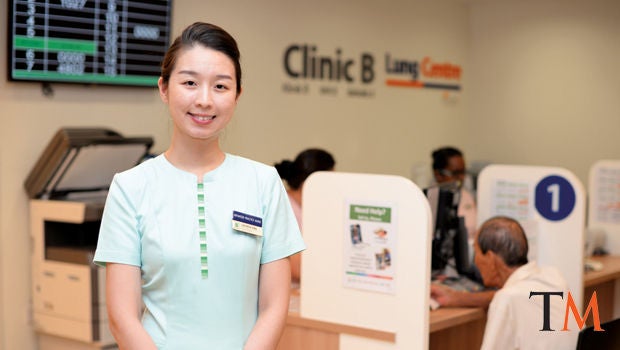
Advanced Practice Nurse Lim Wen Ting (above) provides assistance, reassurance and comfort at each stage of her patients’ journey at the SingHealth Duke-NUS Lung Centre.
When Advanced Practice Nurse Lim Wen Ting saw the photograph of her patient in his living room with his pet dog by his side and looking happy despite having two tubes draining fluid out of his lungs, she knew she had done the right thing.
The patient suffered from stage four lung cancer and was always breathless, panicky and anxious in the ward. He wanted to fight the disease but was too weak for further treatment. Wen Ting spent a long time helping him come to terms with his condition. When he asked to go home, she worked with the palliative and hospice home care teams to arrange his discharge from the hospital.
Lung SDDC: A multi-disciplinary team approach
Helping lung cancer patients manage their end-of-life journey is only one part of what Wen Ting does as part of her duties in the SingHealth Duke-NUS Lung Centre (Lung SDDC).
One of seven SingHealth Duke-NUS Disease Centres, the Lung SDDC is a model of care using a team approach to patient management. Patients with complex lung cancer usually need different outpatient consultations, diagnostic scans, biopsies and treatments at multiple subspecialties at the Singapore General Hospital, National Cancer Centre Singapore and National Heart Centre Singapore. It is a complicated journey for patients to understand and navigate on their own.

"Some patients want to fight the disease until their last breath, while others accept their illness and want to spend their remaining time with their family."
The Lung SDDC attempts to link up the journey in the back end. Cardiothoracic surgeons, respiratory medicine physicians, pathologists, oncologists and radiologists that make up the Lung Cancer Tumour Board review these patients early, even before their diagnosis is confirmed.
If needed, different diagnostic tests are scheduled concurrently and their results presented to the Tumour Board for a coordinated decision. This way, less time is wasted, patients make fewer trips to the hospital and start their treatment earlier.
What is Wen Ting’s role?
To close the loop between physicians and patients, Wen Ting was roped in to the Lung SDDC in October 2016 to assist patients and provide reassurance.
She attends the weekly Tumour Board meeting and learns the conditions and plans for these patients. This allows her to start familiarising herself with these patients at an early stage of their healthcare journey.
“Sometimes I need to contact the patient after a meeting to inform them of changes or help them make appointments. Because our contact start early in the patients’ care journey, I can build rapport with them,” she shared. If patients are subsequently warded, they will have a familiar name to look for.

Above: A multi-disciplinary team meet at the SDDC's Tumour Board to discuss and recommend treatment processes for their patients.
“When patients are recommended tests or treatment by their doctors, they usually have a lot of questions on their mind but may not voice them out. This is where I offer my help,” she added.
Wen Ting spends a lot of time getting to know each patient, understanding their expectations and needs, explaining the plans to them, and helping them address their concerns and fears. Besides the doctors, she works with other healthcare professionals, patients’ family members and social workers to meet the patients’ needs.
Thinking back to the patients she had managed under the Lung SDDC, Wen Ting, who has served thirteen years as an oncology nurse, concluded,
“Some patients want to fight the disease until their last breath, while others accept their illness and want to spend their remaining time with their family. Regardless of their decision, I feel content to have made their healthcare journey less stressful and more comfortable.”













 Get it on Google Play
Get it on Google Play